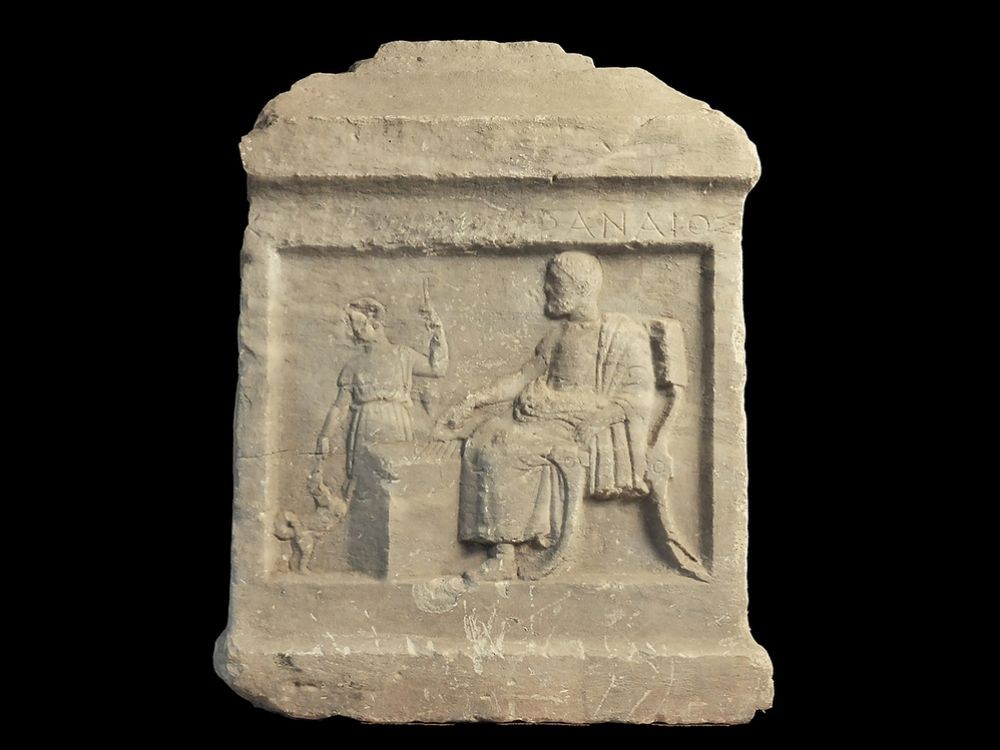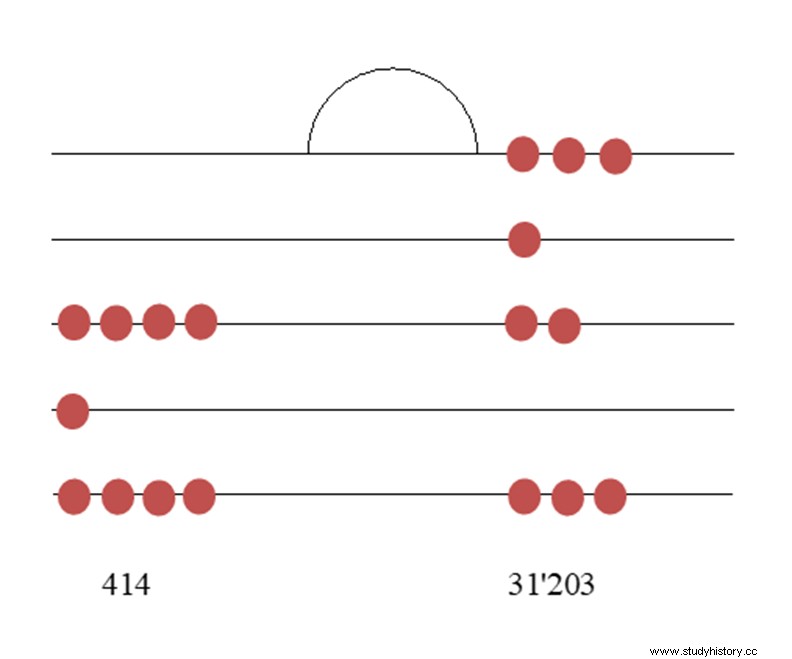A Swiss archaeologist and mathematician have identified on a 2,500-year-old Greek bas-relief a mathematics lesson given by a teacher to his student. They also determined the content of the lesson...

On this fragment of the funerary altar of Phanaios, "he who brings light", we see the teacher pointing out to his student a semi-circle surmounting 5 horizontal lines. This is a lesson in arithmetic, according to the study conducted by two Swiss researchers.
 Here's the oldest depiction of a math lesson from ancient Greece (and you'll get it all! ) Fabrice Nicot 00:00 / 00:00 Your browser does not support the
Here's the oldest depiction of a math lesson from ancient Greece (and you'll get it all! ) Fabrice Nicot 00:00 / 00:00 Your browser does not support the audio element. A seated man, draped in a hem of his garment, points to a block on which are engraved five lines surmounted by a semi-circle. He faces a child who, standing, is playing with his dog. The atmosphere is relaxed and yet... This scene engraved in the 5th century BC on a bas-relief in the necropolis of Krannon (Thessaly, central Greece) would constitute the oldest known representation... of a maths lesson! This is the conclusion of a fascinating investigation conducted jointly by archaeologist Véronique Dasen (University of Fribourg, Switzerland) and Geneva mathematician Jérôme Gavin, published in the Board Game Studies Journal.
A mysterious semi-circle
It all starts with an unknown fragmentary tomb described in a catalog as a game scene. "Our work is part of a European research project around the history of games, Locus Ludi , explains to Sciences et Avenir Veronique Dasen. This bas-relief had therefore been reported to me as showing a child playing a board game with an adult. This immediately struck a chord with me because it is simply impossible. In ancient Greece, adults did not play with children". So why mention a game? The confusion arises from the fact that one of the most popular amusements in the Greek world, the "Grammai Pente", is played on a five-line board, like the one featured on the block. The objective is to align his pawns on the center line. It is possible to play it on the internet via the Locus Ludi website.
This game is often represented on vases, mirrors... But here, a detail attracts the attention of researchers. "The presence of the semi-circle does not fit with the board game. It is never found on the game representations" , notes Véronique Dasen. This is where the mathematician Jérôme Gavin, who is also a specialist in the history of calculation, comes in. He recognizes this configuration of five lines surmounted by a semicircle, and it is not a game. "It appears on what are called monumental abacuses found in temples or shrines, accurate to Sciences et Avenir the specialist. These are very large blocks with lined structures and numbers, number symbols. It was used to make calculations using small pebbles". The thesis of the game moves away, and Véronique Dasen continues the demonstration. "We can see in the image that the lines are engraved on a substantial block, closer to a monumental abacus than to a tray. The man points to the semi-circle with his finger to the child. He is in the demonstration. Finally, his first name, engraved at the top left, Phanaios, means 'the one who brings light'. It's a nice way to designate a teacher!"
The math lesson benefits researchers
We would therefore be in front of a math lesson, but which one? This is one of the most fascinating points of this investigation. Because this 25-century-old course will also benefit our two researchers... These abacuses were used to concretely represent numbers using pebbles placed on the lines (see box). The first represented the units, the second the tens, the third the hundreds, the fourth the thousands, the fifth the ten thousands. This arrangement made it possible to easily perform addition, subtraction, multiplication and division by manipulating the pebbles. It will not be supplanted by the current techniques of more abstract calculation of the Indo-Arabic numeration until the Renaissance.
So much for the theory. But what about practice? " We knew that the Greeks used these abacuses, but did not know in what way precisely, continues the historian of mathematics. For example, how should it be oriented? So that the lines are vertical, or horizontal? Phanaios gives us the answer:we had to stand facing the horizontal lines. And we have demonstrated that by holding the abacus in this way, we can perform the four main operations in a simple way".
NUMBERS AMONG THE GREEKS
Representation of numbers on monumental abacuses. The first line represents the units, the second the tens, the third the hundreds, the fourth the thousands, the fifth the ten thousands. (Click on it to enlarge the image). 
When math was happy...
Thanks to this orientation given by the teacher, the researchers also constructed an original hypothesis to explain the presence of the semi-circle. He would transform the abacus into a tool for making monetary exchange. "The Greek monetary system is in drachmas, recalls Jérôme Gavin. But when we got to 6000 drachmas, we moved on to the talent, a talent worth 6000 drachmas. Our hypothesis is that when we reached this number, we converted the six pebbles placed on the thousands line into a single one placed in the semicircle. This made it easy to perform conversions". In support of this thesis, Véronique Dasen notes that the monumental abacuses were often found in sanctuaries, a place where donations were made and where a lot of money was therefore counted. Moreover, papyri from the Egyptian-Roman era show that the conversion of drachmas into talents was taught to students. Here, the teacher is precisely pointing to the semi-circle...
There remains a question that torments us while observing the scene. What is the dog doing? Again, this places this representation under the sign of education. "Taking care of a dog is part of the education given to a child in Greece. So we show him taking care of him. he child seems playful. The message is probably that he is having fun during this math lesson. This should make us think..." , concludes Véronique Dasen with a smile.
